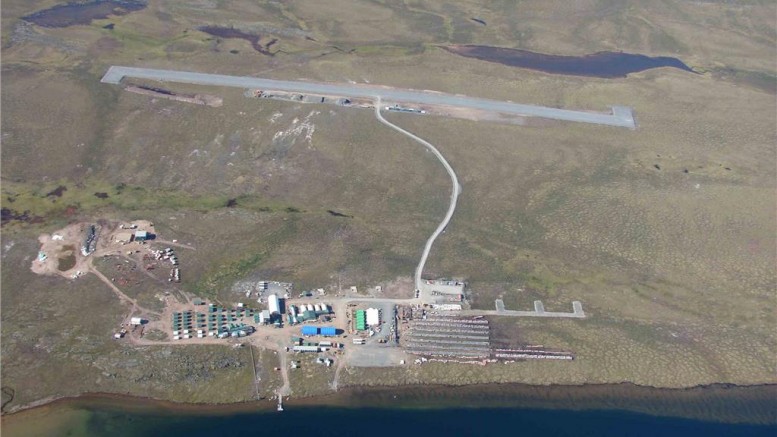VANCOUVER — Sabina Gold & Silver (TSX: SBB; US-OTC: SGSVF) is working hard to outline a development scenario at its Back River gold project in Nunavut that is viable in light of challenging capital markets. On Sept. 13 the company released its latest feasibility study that outlines a mine with a smaller capital cost and what it calls a “lower execution risk.”
The major change for Sabina, which had released another alternative feasibility study on Back River in late June, is halving throughput rates to 3,000 tonnes per day. The smaller mine plan results in a substantial drop in capital expenditures to $415 million and a decrease in sustaining capital to $185 million. The company’s previous plan had tallied $695 million in development costs and $440 million in sustaining capital.
The latest study is based on reserves across the Goose Main, Llama and Umwelt deposits that include 7 million proven tonnes of 5.98 grams gold per tonne and 5.4 million probable tonnes grading 6.7 grams gold. A total of 2.3 million oz. gold would be recovered over the mine life, with cash costs estimated at US$534 per oz., including royalties.
Gold mineralization at Back River is mostly hosted within the Lower Iron Formation and, to a much lesser extent, the underlying sediments. Goose Main, Umwelt and Llama are associated with anticlinal structures that have been structurally thickened, disrupted and cut by axial planar felsic dykes, which apparently trace the fluid pathways and are related to mineralization.
“When we put out our feasibility study in June we were happy with the economic return. However, in this market the [capital expenditure] figure was going to be a challenge for a company of our size,” president and CEO Bruce McLeod said during a conference call.
“Fortunately, the nature of Back River offers opportunity to scale the project, which enabled us to come up with a more compelling and financeable scenario to kick-start production in the district. We’ve drastically reduced the initial capital requirements and outlined a much simpler project that decreases execution risk,” he added.
A boost in cut-off grade has resulted in an overall increase in anticipated head grade over the life-of-mine to 6.3 grams gold. Sabina adds that the new plan results in a 49% improvement in capital efficiency and a “more simplified” mine.
The new plan relies more heavily on open-pit mining. Before, the company assumed that 54% of the life-of-mine mill feed would come from open pits, but this has jumped to 72% with the new plan.
Assuming a gold price of US$1,150 per oz. the project would generate a 24.2% after-tax internal rate of return and US$480-million net present value at a 5% discount rate. Back River would crank out 200,000 oz. gold over its mine life.
“We’ll be able to deliver the financing to cover the initial capital required for the project in a way that’s beneficial for our shareholders,” McLeod said. “The fact is the project has really been simplified since we’re looking at three open pits and one underground mine within 3 km of the processing facility, as opposed to 15 mining areas in the previous feasibility study that were as far as 15 km away.”
The company is now leaving a large amount of resources and exploration potential on the table for later expansions. The George property, 50 km north of Goose, has been removed from the mine plan entirely. George hosts 6.4 million indicated tonnes of 5.55 grams gold and 4.8 million inferred tonnes at 6.3 grams gold.
Meanwhile, Sabina has lined up more than 50 potential drill targets on the George and Goose properties alone. The other claim blocks at Back River, all hosting gold showings, have seen less work and are “relatively unexplored.” Global resources already include 28.2 million measured and indicated tonnes of 5.87 grams gold for 5.3 million contained oz. Inferred resources total 7.8 million tonnes of 7.4 grams gold for another 1.9 million contained oz.
“Expanding a mine when you have the people and infrastructure on-site is nearly always cheaper. We’re really looking at this project as something that is truly scalable,” McLeod explained.
“The best path would involve establishing a centre of operations, spending more dollars on exploration and determining what size of expansion will optimize the district. We know that the returns on those incremental and resources and reserves will definitely be higher once we’ve established our base operations.”
BMO Capital Markets analyst Andrew Kaip notes that the new feasibility study “presents a more realistic development alternative for the project, and highlights the flexibility of development options available for Back River, which is supported by a combination of both open-pit and underground deposits.”
BMO Research models average annual production at Back River of 189,000 oz. at all-in sustaining cash costs of US$585 per oz., beginning in 2020. Kaip has a “market perform” rating on Sabina with a 45¢-per-share price target.
Sabina began Back River’s formal environmental assessment in 2012, and is 75% through the process. The company plans on filing its final environmental impact statement with the Nunavut Impact Review Board in November.
Sabina shares have traded in a 52-week range of 28¢ to 75¢, and have declined 26% since mid-July en route to a 35¢-per-share close at press time. The company has 197 million shares outstanding for a $69-million market capitalization, and reported a $21-million cash balance at the end of June.


Be the first to comment on "Sabina gets ‘more realistic’ at Back River in Nunavut"